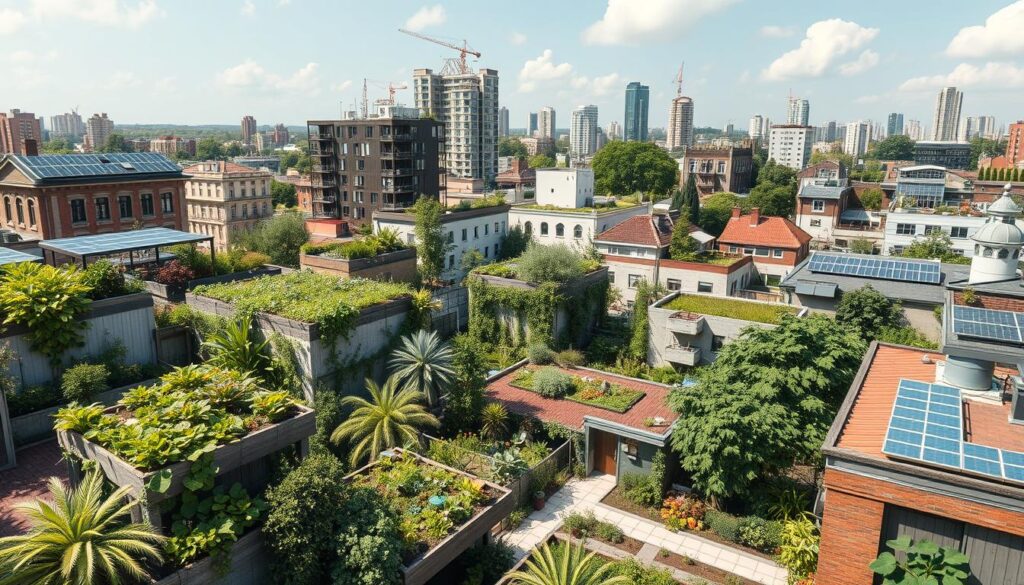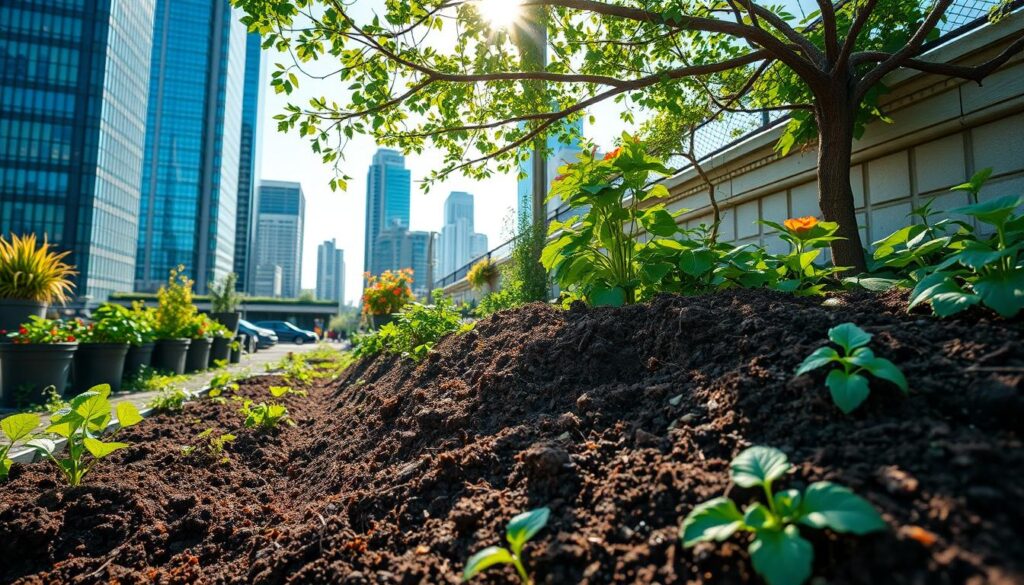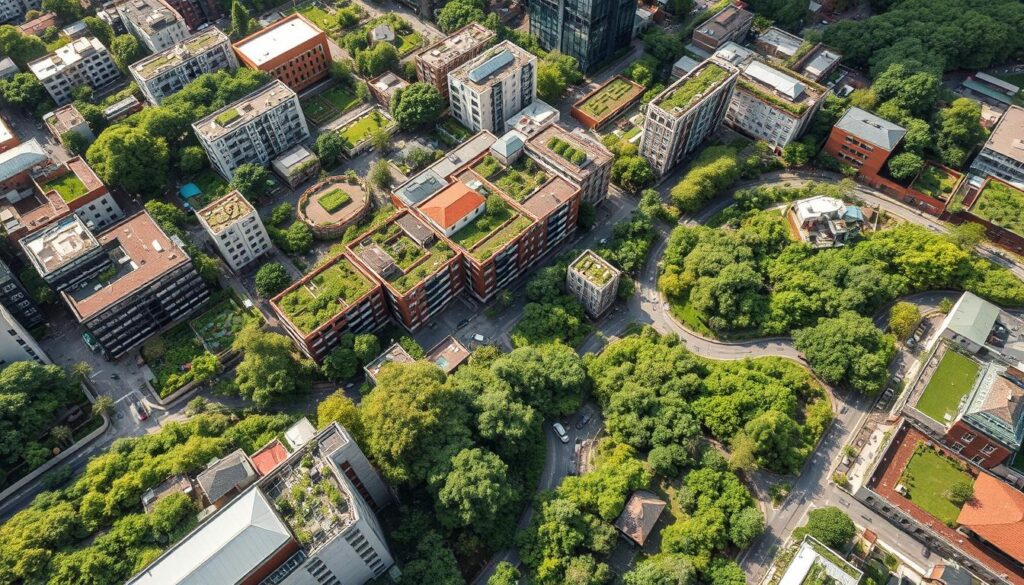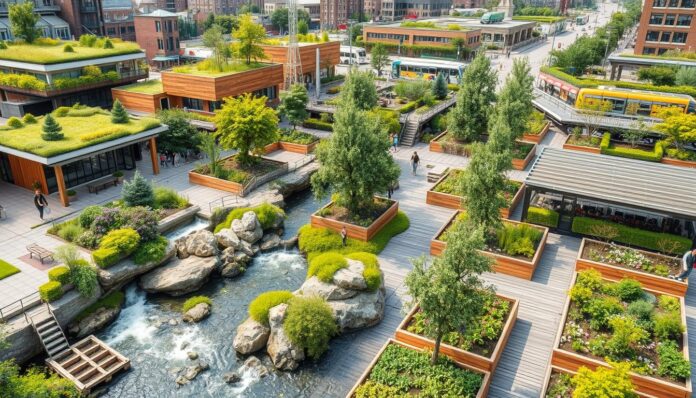More than half of the world’s people live in cities now. This has led to big environmental problems, like more pollution and less resources. About 25% of pollution comes from farming, which hurts our climate. To fix these issues, we need to assess and design cities better using permaculture. Check out permaculture design magazine for more on sustainable design and permaculture.
Assessing urban watersheds is key to finding ways to improve them. By doing a detailed check, cities can make plans to use permaculture. This can lessen the harm of city life on our planet. It can also help cities deal with climate change better, like stronger hurricanes.
Key Takeaways
- Permaculture infrastructure assessment is essential for evaluating urban watersheds and identifying areas for improvement.
- Sustainable design evaluation is critical for creating more resilient and environmentally friendly cities.
- Approximately 25% of net greenhouse gas emissions are attributed to agriculture, which significantly impacts climate change.
- Permaculture principles can help mitigate the effects of climate change and promote more sustainable urban ecosystems.
- Conducting a thorough permaculture infrastructure assessment can help cities develop effective sustainable design evaluation plans.
Understanding Urban Watersheds
Urban watersheds are complex systems that need careful management. This ensures the health of both the environment and people. A regenerative systems analysis can spot areas for improvement. An ecological site assessment gives insights into the ecosystem.
The average American uses 88 gallons of water daily, excluding industrial use. This increases the amount significantly. Managing urban watersheds well is crucial for conserving water and preventing pollution. Nearly 50% of the global population lacks access to safe water, making water management in cities a top priority.
Some key strategies for managing urban watersheds include:
- Implementing low-impact development (LID) strategies to reduce stormwater runoff
- Conducting regular ecological site assessments to monitor the watershed’s ecosystem
- Using regenerative systems analysis to identify areas for improvement
By adopting these strategies, urban watersheds can be managed sustainably. This involves using green infrastructure like parks and green roofs. These help reduce stormwater runoff and improve water quality.
| Strategy | Benefits |
|---|---|
| Low-impact development (LID) | Reduces stormwater runoff, improves water quality |
| Ecological site assessment | Provides insights into the watershed’s ecosystem, identifies areas for improvement |
| Regenerative systems analysis | Helps identify areas where the watershed can be improved, prioritizes environmental sustainability |
The Permaculture Approach
Permaculture is a way to design sustainable ecosystems. It starts with an organic land management review to understand the land’s potential. This approach turns urban watersheds into thriving areas, improving water quality and boosting biodiversity.
A resilient infrastructure audit is key in permaculture. It spots weaknesses and chances for betterment. This audit looks at current water systems and finds ways to make them stronger and greener.
Permaculture in urban watersheds brings many benefits, including:
- Improved water quality through natural processes
- More biodiversity and ecosystem services
- Greater resilience to climate change and extreme weather
- Healthier people through green spaces and nature

By using permaculture, urban watersheds become sustainable and resilient. They offer many advantages for the environment and people living nearby.
| Permaculture Principle | Description |
|---|---|
| Observe and Interact | Observe nature and interact with it gently, to benefit both |
| Catch and Store Energy | Use the environment’s energy, like rain and sunlight, to be self-sufficient |
| Obtain a Yield | Get value from nature, like food, while wasting less and being efficient |
Integrating Water Management Strategies
Effective water management is key for urban planning. Permaculture infrastructure assessment helps a lot. Cities can spot where to improve and make water systems better.
Using plants in cities can fight off extreme weather. For instance, rainwater harvesting collects rain for uses other than drinking. This cuts down on the need for city water.
Rainwater Harvesting Techniques
Rainwater harvesting saves water. It has many benefits:
- Less stormwater runoff
- Less strain on city water
- Lower water bills
Greywater Recycling Solutions
Greywater recycling is also vital. Greywater comes from sinks, showers, and washing machines. It can be used for watering plants and flushing toilets.
By using permaculture and sustainable design, cities can manage water better. This saves water and cuts down on waste.
| Water Management Strategy | Benefits |
|---|---|
| Rainwater Harvesting | Less stormwater runoff, less city water needed |
| Greywater Recycling | More water saved, less wastewater |
Soil Health in Urban Settings
Soil health is key for urban areas, and permaculture helps improve it. Techniques like composting and mulching are used. A regenerative systems analysis finds ways to make soil better. An ecological site assessment shows what’s needed for urban gardens.
Improving urban soil has many benefits:
- More food can be grown
- Air quality gets better
- Less waste goes to landfills
- Biodiversity increases
Studies show urban permaculture can grow 25% more food per square foot. Rainwater harvesting cuts down water use by up to 40%. These steps make urban soil healthier and more sustainable.

A regenerative systems analysis helps plan for better soil. An ecological site assessment gives insights into the soil. Together, they help urban gardens thrive in tough environments.
| Soil Health Benefits | Urban Permaculture Practices |
|---|---|
| Increased food production | Intensive planting methods |
| Improved air quality | Rainwater harvesting systems |
| Reduced waste sent to landfills | Composting and mulching |
Plants and Biodiversity
Choosing native plants is key to making cities sustainable and green. We need to review the local plants and animals first. This helps us pick the right plants for the area. We also check how green spaces fit into the city, improving air, noise, and climate.
Green spaces in cities boost biodiversity and resident well-being. They become homes for local wildlife, helping the environment and building community. Urban planning must carefully consider these green spaces to be good for everyone.
To pick the best plants and design green spaces, we must think about a few things:
– Climate and soil conditions
– Biodiversity and ecological balance
– Community engagement and education
– Organic land management review and resilient infrastructure audit findings
| Factor | Importance | Considerations |
|---|---|---|
| Climate and Soil Conditions | High | Native plant species, soil health, and water management |
| Biodiversity and Ecological Balance | High | Local flora and fauna, ecosystem services, and community engagement |
| Community Engagement and Education | Medium | Workshops, guided tours, and educational materials |
| Organic Land Management Review and Resilient Infrastructure Audit | High | Sustainability, resilience, and environmental impact |
By looking at these factors and doing detailed organic land management review and resilient infrastructure audit, cities can create beautiful green spaces. These spaces not only make the city look good but also help the environment and people’s health.
Ecosystem Services of Watersheds
Healthy watersheds offer many benefits, like filtering water, controlling floods, and creating habitats. It’s key to assess the watershed’s health to spot where it can get better. This helps in managing watersheds better and boosting their services.
Good watersheds support many species, clean our water, and fight climate change. By using permaculture and doing regular checks, we keep our watersheds healthy. This ensures they keep giving us these vital services.
Benefits of Healthy Watersheds
- Water filtration and purification
- Flood control and mitigation
- Habitat creation and biodiversity support

Role of Urban Watersheds in Climate Resilience
Urban watersheds are crucial for fighting climate change. They help lessen the impact of severe weather and support life. By planning cities with sustainability in mind, we make watersheds stronger. This helps both people and nature thrive.
| Ecosystem Service | Benefits |
|---|---|
| Water Filtration | Improved water quality, reduced treatment costs |
| Flood Control | Reduced risk of flooding, protected infrastructure |
| Habitat Creation | Support for biodiversity, improved ecosystem health |
Urban Design for Sustainable Watershed Management
Urban design is key to managing watersheds sustainably. Cities can improve their water systems with green infrastructure and permeable pavements. A regenerative systems analysis helps find ways to use water better.
An ecological site assessment is vital for understanding urban ecosystems. It guides the design of green spaces and parks. These features help cool cities and reduce stormwater runoff.
Innovations in Urban Planning
Urban planning has seen some big changes:
- Green roofs and walls to cut down on stormwater and improve air
- Permeable pavements let rainwater soak into the ground
- Green spaces and parks cool cities and reduce runoff
Examples of Successful Urban Watershed Projects
Cities like Freiburg, Germany, and Copenhagen, Denmark, are leading the way. They’ve invested in green infrastructure and eco-friendly transport. This has cut down on emissions and boosted health.
| City | Initiative | Outcome |
|---|---|---|
| Freiburg, Germany | Green infrastructure and eco-friendly transportation | 20% reduction in greenhouse gas emissions |
| Copenhagen, Denmark | Carbon-neutral goal by 2025 | 30% reduction in carbon emissions |
Community Engagement and Education
Community engagement and education are key for good watershed management. They help people feel they own and care for the environment. An organic land management review shows where we can do better and how to be green. Also, a resilient infrastructure audit makes sure our community spots are ready for learning.
Some big pluses of getting the community involved and educated are:
- More people feel they own and care for the environment
- Students do better in school
- Our community gets closer and works better with local businesses
- There are more chances for internships and jobs
By focusing on community engagement and education, we can build a greener, stronger future. Studies show that when communities lead, they can really change the environment. Up to 70% of people start doing more to reduce waste after being involved. Together, we can make a big difference and improve our communities’ futures.
| Community Engagement Initiative | Outcome |
|---|---|
| Trash Hero workshops | 70% of participants take follow-up actions towards waste reduction |
| Loop’s circular economy model | 60% of consumers adopt reusable packaging |
| Too Good To Go food waste reduction | Over 10 million meals saved from being wasted globally |
Policy and Governance
Good policy and governance are key for managing urban watersheds sustainably. A permaculture infrastructure assessment can spot areas for betterment and improve how resources are used. This way, cities can build systems that are both green and efficient, helping the environment and people.
Getting the community involved is a big part of policy and governance. By letting local people help make decisions, cities can meet their needs and listen to their worries. This can happen through public programs, workshops, and team planning efforts.
Local Policies Affecting Urban Watersheds
Local policies greatly influence how urban watersheds are managed. These policies can either help or hinder green practices, based on their focus and how they’re carried out. A permaculture infrastructure assessment can show where policy changes are needed to support sustainable design and eco-friendly actions.
Advocacy for Sustainable Watershed Management
It’s crucial to advocate for better watershed management. By spreading the word about the value of permaculture and sustainable design, we can shape policy and bring about change. This can be done through reaching out to the community, teaching, and working with local officials.
- Building partnerships with local organizations and stakeholders
- Developing and implementing effective outreach and education programs
- Collaborating with policy makers to promote sustainable practices
- Supporting research and development of new sustainable technologies and methods
| Strategy | Benefits |
|---|---|
| Permaculture infrastructure assessment | Identifies areas for improvement, optimizes resource allocation |
| Sustainable design evaluation | Promotes environmentally friendly practices, increases efficiency |
| Community engagement and education | Increases awareness, involves local residents in decision-making process |
Case Studies of Urban Watersheds
Urban watersheds can greatly benefit from regenerative systems analysis. This approach helps cities manage their resources better. For example, the Texas Hill Country has grown a lot in recent years. To handle this, projects like the Jacob’s Well Studio aim to make cities more sustainable.
These projects focus on creating spaces for everyone, affordable homes, and growing food in a smart way. This not only saves the environment but also keeps cities cool. The permaculture practice shows that cities can live in harmony with nature. This reduces the need for outside resources and cuts down on waste.
Some key features of these projects include:
- Energy and water-efficient commercial/retail spaces
- Walkable mixed-use town centers
- Micro-farms and permaculture gardens
These elements help create a system that’s good for both the planet and people. By using these methods, cities can become greener and stronger. This leads to a better life for everyone living there.
Monitoring and Assessing Watershed Health
Keeping an eye on watershed health is key for managing it well. An organic land management review spots areas that need work. It looks at water quality, soil health, and how many different species live there.
A resilient infrastructure audit is also vital. It checks if the watershed’s systems can handle disasters and climate change. Regular checks help find and fix problems early.
Some important signs of watershed health are:
- Water quality
- Soil health
- Biodiversity
- Infrastructure resilience
By watching these signs, managers can make plans to keep the watershed healthy. They might use organic land management or build resilient infrastructure. This could mean no-till farming or green roofs.
| Indicator | Description |
|---|---|
| Water quality | Measure of the physical, chemical, and biological characteristics of the water |
| Soil health | Measure of the soil’s ability to support plant growth and filter water |
| Biodiversity | Measure of the variety of plant and animal species in the watershed |
| Infrastructure resilience | Measure of the infrastructure’s ability to withstand natural disasters and climate change |
The Future of Urban Watersheds
As the world’s population grows, more people are moving to cities. Over 4.2 billion people now live in urban areas. To keep urban watersheds healthy, we need sustainable practices. Permaculture can help by using its principles in urban planning.
By 2050, urban areas will have 2.5 billion more people. Most of this growth will happen in Asia and Africa. This means we must use sustainable design and permaculture to keep urban watersheds strong.
Trends in Urban Sustainability
Urban areas are moving towards cleaner energy, less waste, and better water use. For example, the Hudson Valley aims to use only renewable energy by 2050. This is a big step towards a greener future.
Vision for Resilient Urban Watersheds
We dream of cities that can handle climate change. To make this happen, we need to use permaculture and sustainable design. These tools will help manage urban watersheds better for the future.
By using these methods, cities can lessen their harm to the environment. They can also make life better for their people. And they can build a sustainable world for future generations.
Resources for Further Learning
If you’re keen on learning more about permaculture and watershed management, there’s a lot to explore. Understanding ecosystems through regenerative systems analysis is key. An ecological site assessment guides us in using land wisely.
Here are some top picks for resources:
- Permaculture organizations and networks, such as the Permaculture Association and the International Permaculture Convergence
- Books on watershed management, such as “Watershed Management: A Guide for Communities” and “Permaculture: A Designer’s Manual”
- Online courses and workshops, such as those offered by the Regenerative Design Institute and the Permaculture Research Institute
These resources offer a wealth of knowledge. They help us apply permaculture and regenerative systems analysis to our projects. By assessing our ecological site, we can make sustainable decisions for our land and resources.
| Resource | Description |
|---|---|
| Permaculture Association | A global network of permaculture practitioners and organizations |
| International Permaculture Convergence | A biennial conference bringing together permaculture practitioners from around the world |
Conclusion: The Path Forward
Managing urban watersheds with permaculture is a smart, sustainable way. It shows us the value of reviewing land management and checking infrastructure for resilience. These steps are key to better managing our urban watersheds.
Summary of Key Insights
Permaculture teaches us to observe and work with nature. It helps us store energy and mix different elements together. This approach makes urban watersheds stronger and more self-sufficient.
Improving soil health and choosing native plants are crucial. So is finding new ways to handle stormwater. These actions help cities lessen the bad effects of urban growth and keep watersheds working well.
Call to Action for Urban Communities
Improving urban watersheds needs everyone’s help. Local governments, planners, groups, and citizens must work together. We urge people to join land management reviews and support infrastructure checks in their cities.
By using permaculture, we can make our urban watersheds healthy and balanced. This will help our communities be more sustainable and provide important services.

